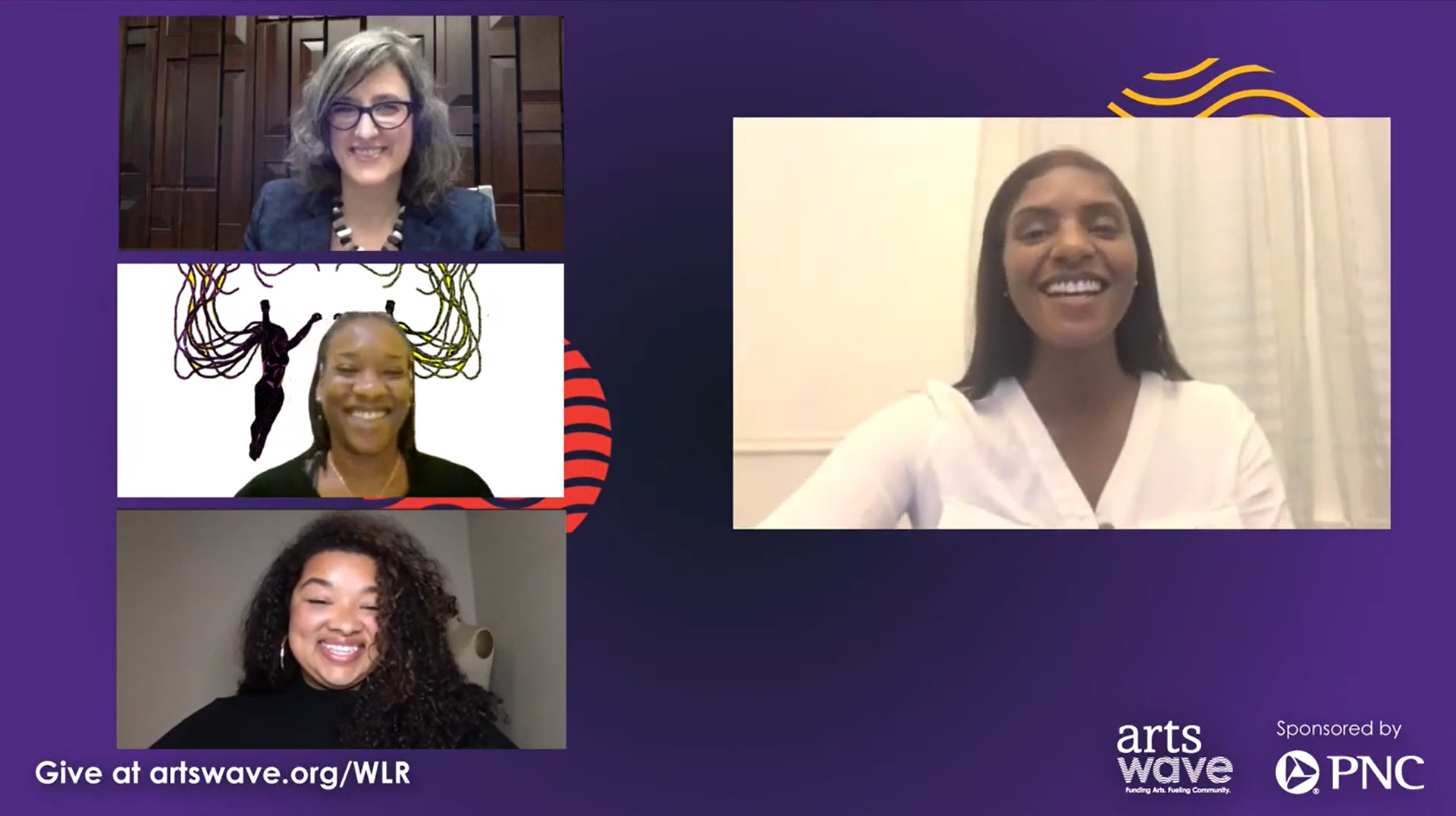posted by Amanda McDonald ON
Jan 12, 2021

A group of ArtsWave leadership donors who are focused on the impact, reach and quality of the arts in the Cincinnati region, recently gathered during the fifth annual Women’s Leadership Roundtable Symposium, sponsored by PNC. The topic for this year’s forum was how women in the arts are “making waves” in the community and in their respective spheres of influence.
Ray Ball, founder of BallR Media and co-founder of Paloozanoire, moderated the discussion which was held virtually. Panelists included Ainsley M. Cameron, Ph.D., curator at Cincinnati Art Museum; Daryl Myntia Daniels, painter, designer, illustrator, and designer of the ArtWorks Black Excellence in Zone 15 mural; and Kate Tepe, a Cincinnati-based artist.
Cameron opened the discussion by sharing how the Cincinnati Art Museum is creating space for critical thinking and conversations around gender. The museum’s exhibition, Women Breaking Boundaries 2.0, features work by self-identified female artists in the museum’s permanent collections. The exhibition has challenged the museum to reflect on the representation of female artists in their collections.
Cameron’s comments centered around how women can take or create space for hard conversations to happen and drive change, especially in traditionally male and white-dominated spaces, such as museums. Driving change as a female leader is an ongoing process. According to a 2017 report by the Association of Art Museum Directors and the National Center for Arts Research, women occupy fewer directorships at museums and earn 73 cents for every dollar earned by male directors. To continue to disrupt these spaces, she suggests “a two-pronged approach: be in the main spaces and be in there with elbows out. Be there to change the space and create a sense of community and be the strongest version of ourselves.
Daniels, a visual artist from Cincinnati, now living and working in the Bronx, New York, talked about her new mural, Black Excellence in Zone 15, in Lincoln Heights. Daniels designed and led a team of ArtWorks Youth Apprentices to create an homage to her hometown which traces the village’s origins to present times as the first all-Black self-governing community above the Mason Dixon line. It celebrates some of Lincoln Heights’ most influential residents, including: Olympians Mae Faggs Starr and William DeHart Hubbard (the first Black person to win a gold medal in an individual event for the running long jump at the 1924 Paris Olympics); sports stars Tony Yates, Greg Stimerick and Darryl Hardy; and musicians The Isley Brothers.
Daniels’ discussed how it feels to be the only or first Black woman in the room, a situation she’s experiences on many occasions. She explained how art has helped her unleash her frustrations about micro-aggressions. Through art, she explained, “seeing ourselves reflected makes the world know we exist.” Within communities, representation through art helps people to grow and heal and bridge cultural divides. Community projects like Black Excellence in Zone 15, help young artists gain experience and confidence.
Cincinnati-based artist Tepe recently collaborated on the Black Lives Matter public street mural project located across from Cincinnati City Hall. Her work explores identity expression, and this year, she is looking deeper into the definition of what and who is “essential.” She asked the group to consider that artists are essential workers during the Coronavirus pandemic because of their contributions to communal growth and personal happiness. “During this time, we should be lifting and valuing artists and art workers,” she says.
She’s not the only one who shares those beliefs. According to the National Endowment for the Arts, “the arts provide comfort, resilience, wisdom, and the means for self-expression and connection, perhaps even more so during challenging times such as these.”
Tepe challenged the group to rebuild the post-pandemic world in a way that values the “essential need for creative expression” — to reach for something more vibrant than getting “back to normal.” The group discussed how these unique times have created so many first-time and unusual learnings that we now have an opportunity to incorporate in our work going forward. She further reinforced, gaining a lot of agreement from the group, that “Going back to normal, would be a disservice.”
The annual Women’s Leadership Roundtable Symposium is just one of the arts experiences and networking opportunities members of this group are invited to throughout the year. This year’s symposium was hosted by a steering committee, which was chaired by Kelly Wittich. Launched in 2014, the Women’s Leadership Roundtable recognizes women leaders who support ArtsWave with an annual leadership gift of $1,500 or more and is more than 400 members strong. Join today by making a leadership donation and opting in at artswave.org/give.